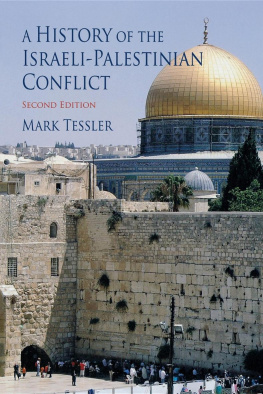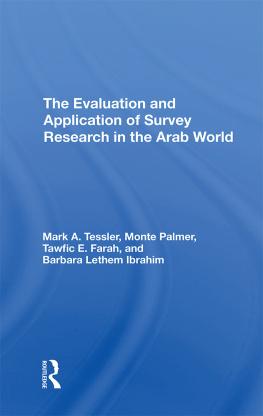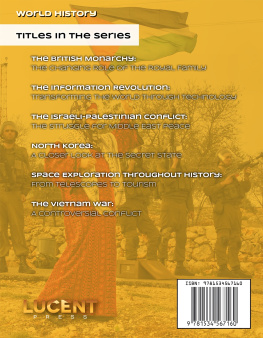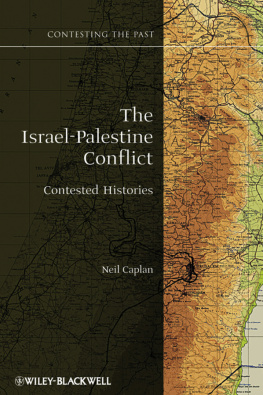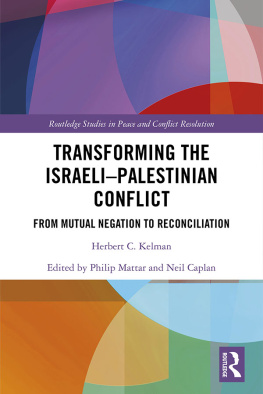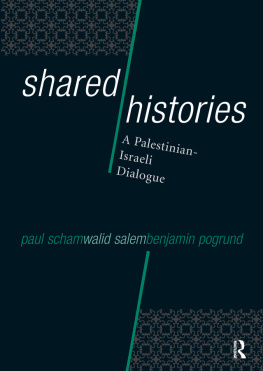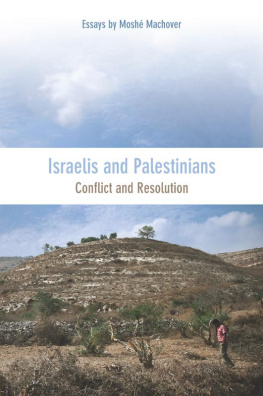This book is a publication of
Indiana University Press
601 North Morton Street
Bloomington, IN 47404-3797 USA
http://iupress.indiana.edu
Telephone orders Fax orders Orders by e-mail | 800-842-6796 812-855-7931 |
1994, 2009 by Mark Tessler
All rights reserved
No part of this book may be reproduced or utilized in any form or by any means, electronic or mechanical, including photocopying and recording, or by any information storage and retrieval system, without permission in writing from the publisher. The Association of American University Presses Resolution on Permissions constitutes the only exception to this prohibition.

The paper used in this publication meets the minimum requirements of the American National Standard for Information SciencesPermanence of Paper for Printed Library Materials, ANSI Z39.48-1992.
Manufactured in the United States of America
The Library of Congress has cataloged the first edition as follows:
Tessler, Mark A.
A History of the Israeli-Palestinian conflict / Mark Tessler.
p. cm. (Indiana series in Arab and Islamic studies)
Includes bibligraphical references and index.
ISBN 0-253-35848-5. ISBN 0-253-20873-4 (pbk.)
1. Jewish-Arab relations1917 2. Israel-Arab conflicts. I. Title. II. Series.
DS119.7.T443 1994
956dc20 93-34049
ISBN-13 978-0-253-35848-6. ISBN-13 978-0-253-22070-7 (pbk.)
3 4 5 6 15 14 13 12
Preface to the Second Edition
Is there a solution to the Israeli-Palestinian conflict? Was there ever one? Can one be found in the future?
These questions usually lead to thoughts about the partition of historic Palestine, meaning division of the territory in order to create one state for Jews and another for Arabs. This two-state solution was proposed by a British Commission of Inquiry as early as 1937, when Palestine was still under the British Mandate. It was proposed again by the United Nations in 1947, six months before Israel declared its independence in May of the following year.
Although partition is the solution to which the international community has consistently returned, and the only one embraced, at least in principle, by majorities both in Israel and among West Bank and Gaza Palestinians, other formulae have been advanced over the years. After the war of June 1967, attention focused on a land-for-peace formula. It called for Israel to return territory captured in the war to its Arab neighbors and for the Arab world to recognize Israel in return. Enshrined in United Nations Resolution 242, the land-for-peace formula did not provide for a Palestinian state, although some Israelis argued that Palestinians could realize their national aspirations in Jordan. In support of their argument, these Israelis noted that Palestinians constituted more than half of Jordans population. Palestinians, for their part, rejected the land-for-peace formula because it did not recognize their right to a state in historic Palestine. They insisted that Jordan is not Palestine and pointed out that Palestinians had only come to Jordan as refugees when Israel was established or, in some cases, after the June 1967 war.
A different solution was put forward by the Palestine Liberation Organization in the late 1960s, and it gained currency in some international circles in the years that followed. In contrast to the two-state solution and land-for-peace formula, the PLO called for the establishment of a single non-denominational state in which Jews and Palestinians would live together as equals. Advocates of this democratic secular state proposal, sometimes described as a one-state solution, declared that their vision recognized both Jewish and Arab rights in Palestine. They also argued that the democratic character of the proposed state would enable Jews and Palestinians to work together for the development of their society. Israelis rejected this proposal, however. Demanding more than the right of Jews to live in a non-denominational state, they insisted on recognition of Israels right to exist as an independent Jewish and Zionist state.
The case for a two-state solution continued to be made during much of this period, and by the mid-1980s, and especially following the outbreak of the first intifada in December 1987, partition was again at the center of discourse and debate. While there remained disagreement about specific issues, including borders, security, Jerusalem, Israeli settlements, and Palestinian refugees, the majority of Israelis and Palestinians, as well as much of the international community, embraced the idea that a Palestinian state should be established in all or at least most of the West Bank and Gaza and that, with Palestinian national aspirations thus fulfilled, this state would live in peace with the Jewish state next door.
The first edition of this book traces the emergence of these and other proposals, as well as the debates and allegations surrounding them and the reasons that none brought sustained progress toward peace. Published in 1994, it carried the narrative forward through September 1993, when Israel and the PLO signed a Declaration of Principles promising mutual recognition and establishing transitional arrangements leading to a two-state solution. Often described as the Oslo Accord, since it resulted from secret negotiations that took place in Norway, the Declaration of Principles fostered optimism that a historic breakthrough might be achieved. Despite their doubts and a history of distrust, a significant proportion of Israelis and Palestinians supported the accord and expressed the hope that now, for the first time, there existed the possibility of genuine progress toward peace.
This cautious optimism is reflected in the preface to the first edition, which I hope will be read along with these new introductory comments. The earlier preface also describes the point of view that informs this volume. First, the book proceeds on the assumption that both Jews and Arabs have legitimate political rights in Palestine; that the validity of these rights does not depend on the absence of corresponding rights possessed by the other party to the conflict; and that these rights are inalienable, meaning that they are not forfeited by whatever misguided or even unethical actions might be taken by a communitys leaders. These normative positions define what might be called an approach-approach perspective. Second, and consistent with this perspective, the book seeks not only to present a balanced and accurate history of the Israeli-Palestinian conflict, it also strives to encourage a sympathetic understanding of the parties involved. Informed by my years of study in both Israel and the Arab world, I earlier described this approach as objectivity without detachment.
The hope reflected in the earlier preface is only in part a reflection of the historic moment at which the first edition of this book was completed. Although encouraged by the Declaration of Principles and the optimism it spawned, it also reflected a less situation-dependent conviction. As the perspective outlined above suggests, I believe that one of the greatest obstacles to peace has been each sides distrust of the other and, in particular, the fact that this distrust has been fed by stereotypes, misconceptions, and propaganda that lead each side to see its adversary as uninterested in, and unworthy of, genuine compromise. The all-too-common tendency has been for Israelis and Palestinians and their respective supporters to see one another as motivated not by legitimate aspirations and an understandable response to their experience and circumstances but, rather, by primordial and hence unchangeable impulses and even hatreds.

 The paper used in this publication meets the minimum requirements of the American National Standard for Information SciencesPermanence of Paper for Printed Library Materials, ANSI Z39.48-1992.
The paper used in this publication meets the minimum requirements of the American National Standard for Information SciencesPermanence of Paper for Printed Library Materials, ANSI Z39.48-1992.
